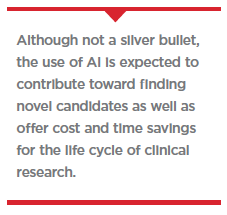 Discovering and bringing new drugs to market is notoriously slow and costly for a reason. Science moves slowly because of the incredibly complex nature of human biology and the difficulty of sluggish recruitment of clinical trials.
Discovering and bringing new drugs to market is notoriously slow and costly for a reason. Science moves slowly because of the incredibly complex nature of human biology and the difficulty of sluggish recruitment of clinical trials.
And in spite of greater investments in R&D by pharmaceutical companies, the number of new drug approvals has declined. Although not a silver bullet, the use of AI is expected to contribute toward finding novel candidates as well as offer cost and time savings for the life cycle of clinical research.
Today pharmaceutical organizations are getting a lift from artificial intelligence (AI) as it provides the ability to sort through massive volumes of data in shorter time periods to find patterns that increase the efficiency of all major processes in the drug development life cycle.
Six Drivers of Adoption
In looking ahead there are six key areas that research from Frost & Sullivan show will increase the adoption and use of AI in the pharmaceutical industry.i
1. Target Discovery and Validation
Identification of drug targets from network-guided machine learning/AI is on the rise in pharma and biotech companies. Target prioritization and validation of hypothesses linking drug targets to disease mechanisms can increase success rates for certain molecules for a given therapeutic area, reducing time to human trials and ultimately to market.
2. Focus on Candidate Discovery
AI can be used for augmented design and conditional automation, predicting efficacy and safety of a new molecule and identification of secondary (life cycle) opportunities.
3. Drug Repurposing
AI will enable extracting insights from the peer-reviewed, patent literature, patient data, and other sources to identify the right already existing compounds for a particular disease. AI can aid in the decision making of combination drug trials, multiple cohorts, and advanced trials, ultimately increasing the overall success rate of delivering life-saving treatment options.
4. Clinical Trial Design & Recruitment
Patient recruitment is tedious and one of the major reasons for exorbitant cost and trial failure. AI and digitization can support trial design, protocol development, and patient matching and stratification/enrollment.
5. Clinical Trial Optimization & Execution
Digitization supported with AI can resolve the many challenges resulting in high trial costs. From protocol optimization, appropriate site selection, drug adherence and compliance tracking, to reduction of adverse events, the use of AI can greatly reduce the manual and monotonous tracking that is needed during a trial life cycle.
6. Precision Genomics
The complexity of data coming from a variety of sources can be overcome by applying AI and Big Data techniques. AI can be applied towards patient stratification, improving diagnosis, and decision support that augments the capability of clinicians.
Partnerships Key to Moving Forward
 Partnerships leveraging innovative pharma and life-sciences organizations and technology organizations such as Microsoft with cloud-based AI technology are crucial to delivering life-saving drugs to those with unmet needs faster and more efficiently.
Partnerships leveraging innovative pharma and life-sciences organizations and technology organizations such as Microsoft with cloud-based AI technology are crucial to delivering life-saving drugs to those with unmet needs faster and more efficiently.
Microsoft has begun an AI-based collaboration with leading global medicine company, Novartis, to transform drug development and commercialization.
Similar collaborations and partnerships will continue to arise as the focus on data science and AI models become more prolific and value is seen from the early collaborations and partnerships. Goals of reducing time to market, increasing operational efficiency, and reducing costs can be aided by expanding relationships between life-sciences organizations and big tech companies.(PV)
Editor’s Note: i Growth Insight—Role of AI in the Pharmaceutical Industry Global, 2018–2022, Frost & Sullivan, September 2019
Microsoft Health and Life Sciences empowers healthcare organizations of all sizes to reimagine the ways they bring together people, processes, and health data insights to improve care delivery.For more information, visit microsoft.com.










